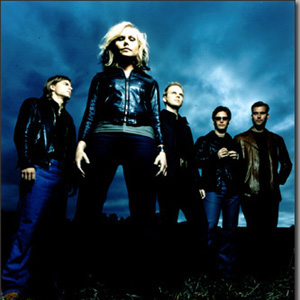It’s funny how such things work. You have an ethos, a style, a persona, and you are pretty strictly adherent to it. You let up a little bit, maybe for a lark or maybe for calculation’s sake and, bam!, recognition. But the severity and depth of that recognition is so complete, a decent body of work cannot stand against it and you are suddenly trapped by that joke, that strategic move, and maybe you deserve it. I’m not convinced that The Cardigans deserve it, though.
 The Swedish band had two rock albums previous to being signed by Mercury Records. They were proudly proclaiming it, and after the release of third record First Band On The Moon, were defensively claiming it. That’s because that album contained the song that would be their shot to the stratosphere, the disco-pop ditty “Lovefool.” Even if the portmanteau title is unfamiliar to you, the song cannot be. It’s impossible that you’ve never heard lead singer Nina Persson’s thick Swede accent cooing, “Luf me, luf me, say that you luf me, fool me, fool me, go on and fool me.” It was on nearly every radio station barring country stations that were up to their throats in Shania, Faith, and Garth. It was added to the soundtrack of Baz Luhrman’s adaptation of Romeo and Juliet, and to the soundtrack of Cruel Intentions. The band played it, and themselves, on Beverly Hills, 90210. That point is key. They weren’t caught up in the machinery of a massive company’s promotions — they were active in turning those gears.
The Swedish band had two rock albums previous to being signed by Mercury Records. They were proudly proclaiming it, and after the release of third record First Band On The Moon, were defensively claiming it. That’s because that album contained the song that would be their shot to the stratosphere, the disco-pop ditty “Lovefool.” Even if the portmanteau title is unfamiliar to you, the song cannot be. It’s impossible that you’ve never heard lead singer Nina Persson’s thick Swede accent cooing, “Luf me, luf me, say that you luf me, fool me, fool me, go on and fool me.” It was on nearly every radio station barring country stations that were up to their throats in Shania, Faith, and Garth. It was added to the soundtrack of Baz Luhrman’s adaptation of Romeo and Juliet, and to the soundtrack of Cruel Intentions. The band played it, and themselves, on Beverly Hills, 90210. That point is key. They weren’t caught up in the machinery of a massive company’s promotions — they were active in turning those gears.
As is often the case with songs that kill career momentum, the band will state they are one thing and the audience says in response, “No, you’re not.” Initially, The Cardigans’ embrace and forceful backing of “Lovefool” hid any discomfort they may have had with the track, but when critical mass was achieved, and the track was added to top-pop Muzak channels, ensuring it would be played three times a day, every day, until the end of time, they quickly backtracked. “We’re really a rock band!” they would say. “This song is an anomaly,” then, “This song is an outlier,” then, “This song is a joke.” The more they dug in, it seemed, the more the public replied, “You are ‘Lovefool,’ ‘Lovefool’ is you. Deal with it.”
The Cardigans were correct, though. The sound of “Lovefool” is not their standard operating procedure, which makes their situation a bit tragic. It would be different if they were, say, Dishwalla whose output sounds a lot like “Counting Blue Cars,” or Tonic, whose output sounds a lot like “If You Could Only See.” “Lovefool” winds up sounding an awful lot like a Swedish pop ancestor, which had been derided for a long period of time between their hits and renewed acceptance. ABBA was a dominant force in the Seventies, but was often slagged for being too pop, if such a condition is actually possible.
 What that really meant was that they didn’t sound suitably European enough, or being more granular, didn’t sound British enough. You couldn’t fit ABBA and The Beatles and The Stones in the same bucket neatly. ABBA was a little more like Petula Clark (“Downtown”) or Lulu (“To Sir With Love”), but even then, not quite. They weren’t rock, but then, what was “Waterloo,” their Eurovision Song Contest entry? For decades between their biggest splash and a relatively recent reappraisal of their output, ABBA was a guilty pleasure for many and just guilty for others. That change started to ’round the horn with the advent of the musical Mamma Mia, and then the hipsters — eternally contrarian as they are — started proclaiming hidden virtues. In the end, a large part of the retrospective cuturistas had to admit: the worst crime the band had committed was in being Swedish and not afraid to sound like it.
What that really meant was that they didn’t sound suitably European enough, or being more granular, didn’t sound British enough. You couldn’t fit ABBA and The Beatles and The Stones in the same bucket neatly. ABBA was a little more like Petula Clark (“Downtown”) or Lulu (“To Sir With Love”), but even then, not quite. They weren’t rock, but then, what was “Waterloo,” their Eurovision Song Contest entry? For decades between their biggest splash and a relatively recent reappraisal of their output, ABBA was a guilty pleasure for many and just guilty for others. That change started to ’round the horn with the advent of the musical Mamma Mia, and then the hipsters — eternally contrarian as they are — started proclaiming hidden virtues. In the end, a large part of the retrospective cuturistas had to admit: the worst crime the band had committed was in being Swedish and not afraid to sound like it.
But we’re not talking about ABBA. The Cardigans made a light, bouncy pop tune that, when placed in its proper context, is better than one remembers. That proper context has limits. You cannot hear the song a lot. You cannot have it force fed down your gullet from every direction and angle. Then it becomes infinitely irritating, but given space its assets are clearly visible. Had the record label, and The Cardigans themselves, not backed this perceived “winning horse” so completely and had the confidence to be as forthright with other tracks, we probably wouldn’t be where we are now.
That means that we probably wouldn’t recognize The Cardigans so clearly. They’d probably be on the same recognition plane as Bettie Serveert. The push and pull that constantly drives the members of The Cardigans apart, then brings them back together, might not be so chaotic, but it might also mean that they’d never get back together. If there’s no financial gain in that reunion, why sweat it? Persson recently released her first solo album, Animal Heart. There is no indication of a quick return to the band.
 While I have come to accept “Lovefool” as a better song than I used to think, I really have no desire to hear it of my own accord. The full court press attached to selling that track, and them in conjunction, was one of the more intense efforts of the 1990s. Little did we realize that this sort of multilevel binge marketing of pop stars would become the accepted norm by the mid-2000s. Now, if your song is not immediately licensed for commercials, movie soundtracks, TV shows, ringtones, and anywhere else music is used and abused, you do not achieve acceptable penetration and are immediately considered a risk to your benefactors. It might just be that, in this bizarre way, The Cardigans were way ahead of their time.
While I have come to accept “Lovefool” as a better song than I used to think, I really have no desire to hear it of my own accord. The full court press attached to selling that track, and them in conjunction, was one of the more intense efforts of the 1990s. Little did we realize that this sort of multilevel binge marketing of pop stars would become the accepted norm by the mid-2000s. Now, if your song is not immediately licensed for commercials, movie soundtracks, TV shows, ringtones, and anywhere else music is used and abused, you do not achieve acceptable penetration and are immediately considered a risk to your benefactors. It might just be that, in this bizarre way, The Cardigans were way ahead of their time.
In our next column, we’ll discuss another band afflicted by one-hit-wonder omnipresence, but unlike The Cardigans, seemed to never have wanted the limelight.





Comments